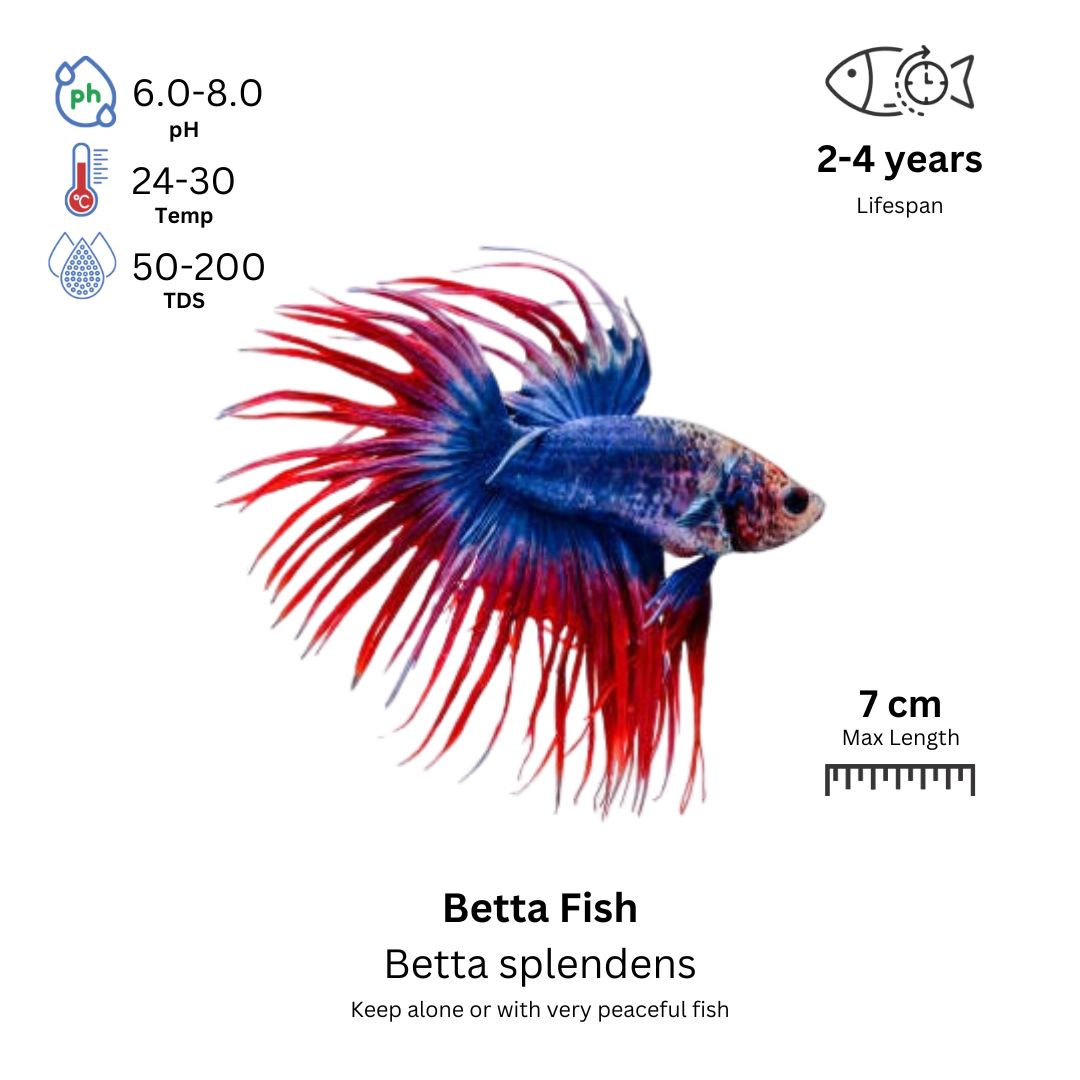No products in the cart.
Betta Fish: Species Profile
Characteristics
- Scientific Name: Betta splendens
- Family: Osphronemidae
- Origin: Southeast Asia (Thailand, Cambodia, Vietnam)
- Social Behavior: Males are territorial; females can be kept in groups
- Tank Level: Top to mid-level
- Minimum Tank Size: 5 gallons
- Diet: Carnivore
- Breeding Method: Bubble nester
- Care Level: Beginner-friendly
- Preferred pH Range: 6.5 to 7.5
- Water Hardness: 5 to 20 dGH
- Temperature Range: 76 to 81°F (24 to 27°C)
Origin and Distribution
Betta fish, commonly known as Siamese fighting fish, are native to the shallow waters of Southeast Asia, particularly in Thailand, Cambodia, and Vietnam. They inhabit rice paddies, slow-moving streams, and floodplains, environments characterized by warm temperatures and dense vegetation.
Colors and Markings
Betta fish are renowned for their vibrant colors and flowing fins. Through selective breeding, they exhibit a wide range of hues, including red, blue, green, and multicolored patterns. Their fins come in various shapes, such as veil, crown, and half-moon, adding to their striking appearance.
Tankmates
Due to their territorial nature, especially among males, careful consideration is needed when selecting tankmates:
- Suitable Companions:
- Peaceful species like corydoras catfish
- Small rasboras
- Snails
- Avoid:
- Other male bettas
- Fin-nipping species
- Large, aggressive fish
Always monitor interactions to ensure harmony within the tank.
Care
Betta fish are relatively hardy but require specific conditions to thrive:
- Tank Setup: Provide a minimum of 5 gallons with a lid to prevent jumping. Include plants and hiding spots to mimic their natural habitat.
- Water Parameters: Maintain stable conditions within the preferred ranges. Regular water changes and efficient filtration are essential to keep ammonia and nitrate levels low.
- Temperature: Use a heater to keep the water between 76 to 81°F (24 to 27°C).
- Filtration: Opt for gentle filtration to avoid strong currents, as bettas prefer calm waters.
Diet and Feeding
As carnivores, betta fish thrive on a protein-rich diet:
- Staple Foods: High-quality betta pellets or flakes.
- Supplements: Live or frozen foods such as brine shrimp, daphnia, and bloodworms.
- Feeding Frequency: Offer small amounts once or twice daily, ensuring they consume all the food within a few minutes to prevent overfeeding and maintain water quality.
Gender Differences
Males typically display more vibrant colors and have longer, more elaborate fins. Females are generally smaller with shorter fins and may exhibit horizontal stripes when stressed or ready to breed.
Breeding
Breeding betta fish requires careful preparation:
- Breeding Tank: Set up a separate tank with shallow water, around 6 inches deep, and a temperature of 78 to 80°F (25 to 27°C). Include a gentle filter and floating plants.
- Spawning: Introduce the female to the male’s tank using a divider. Once the male builds a bubble nest and both display readiness, remove the divider. The male will embrace the female, leading to egg release and fertilization.
- Post-Spawning: Remove the female immediately after spawning to prevent aggression. The male will tend to the nest and eggs.
- Fry Care: Once fry are free-swimming, remove the male. Feed the fry infusoria or commercially available liquid fry food until they are large enough to accept finely crushed flake food or baby brine shrimp.
Further Research
For more detailed information on betta fish care, breeding techniques, and tank setups, consider exploring specialized aquarium literature or consulting with experienced aquarists.
FAQ
Can betta fish live in bowls? While bettas are often kept in bowls, it’s not ideal. A tank of at least 5 gallons with proper filtration and heating is recommended for their well-being.
How long do betta fish live? With proper care, bettas can live between 3 to 5 years.
Do betta fish need a filter? Yes, a gentle filter helps maintain water quality, though it’s essential to ensure the current isn’t too strong for them.


Reviews
There are no reviews yet.